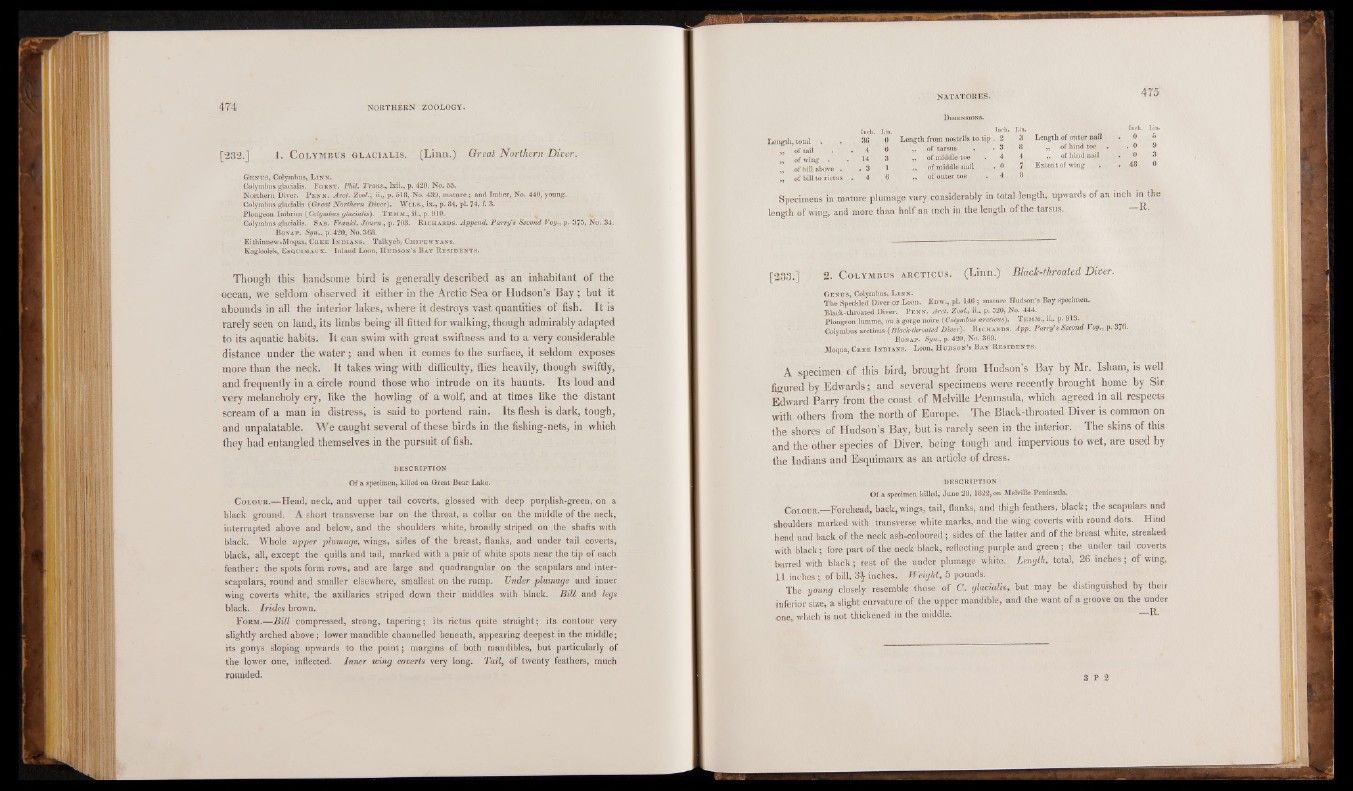
[232.J 1. C o l y m b u s g l a c ia l is . (Linn.) Great Northern Diver.
Genus, Colymbus, Lin n .
Colymbus glacialis. F oust. Phil. Trans., lxii., p. 420. No. 55.
Northern Diver. P enn. Aret. Zoolr,ii., p. 518, No. 439, mature •, and Imber, No. 440, young.
Colymbus glacialis (Great Northern Diver). Wils., ix., p. 84, pi. 74, f. 3.
Plongeon Imbrim ( Colymbus glacialis). Temm., ii., p. 910.
Colymbus glacialis. Sab. Frankl. Journ., p. 703. Richards. Append. Parry's Second Voy., p. 375, No. 34.
Bonab. Syn., p. 420, No. 368.
Eithinnew-Moqua, Cree I ndians. Talkyeh, Chipewyans.
Kagloolek, Esquimaux. Inland Loon, Hudson’s Bay Residents.
Though this handsome bird is generally described as an inhabitant of the
ocean, we seldom observed it either in the Arctic Sea or Hudson’s Bay; but it
abounds in all "the interior lakes, where it destroys vast quantities of fish. It is
rarely seen on land, its limbs being ill fitted for walking, though admirably adapted
to its aquatic habits. It can swim with great swiftness and to a very considerable
distance under the water; and when it comes to the surface, it seldom exposes
more than the neck. It takes wing with difficulty, flies heavily, though swiftly,
and frequently in a circle round those who intrude on its haunts. Its loud and
very melancholy cry, like the howling of a wolf, and at times like the distant
scream of a man in distress, is said to portend rain. Its flesh is dark, tough,
and unpalatable. We caught several of these birds in the fishing-nets, in which
they had entangled themselves in the pursuit of fish.
DESCRIPTION
Of a specimen, killed on Great Bear Lake.
C olo u r .—Head, neck, and upper tail coverts, glossed with deep purplish-green, on a
black ground. A short transverse bar on the throat, a collar on the middle of the neck,
interrupted above and below, and the shoulders white, broadly striped on the shafts with
black. Whole upper plumage, wings, sides of the breast, flanks, and under tail coverts,
black, all, except the quills and tail, marked with a pair of white spots near the tip of each
feather: the spots form rows, and are large and quadrangular on the scapulars and interscapulars,
round and smaller elsewhere, smallest on the rump. Under plumage and inner
wing coverts white, the axillaries striped down their middles with black. Bill and legs
black. Irides brown.
F orm.—Bill compressed, strong, tapering; its rictus quite straight; its contour very
slightly arched above; lower mandible channelled beneath, appearing deepest in the middle;
its gonys sloping upwards to the point; margins of both mandibles, but particularly of
the lower one, inflected. Inner wing coverts very long. Tail, of twenty feathers, much
rounded.
Inch.
Length, total . -• 36
,, of tail . . 4
,, of wing . • 14
„ .of bill aboye . - . 3
„ of bill to rictus . 4
Dimensions.
Inch Lin. Inch. Lin
Length from nostrils to tip . 2 3 Length of outer nail 0 5
’ „ of tarsus . 3 8 „ of hind toe . . 0 9
,, of middle toe 4 4 ,, of hind, nail . 0 3
. „ of middle iiail. 1 0 7 Extent of wing . . 48 0
,, of outer toe I 8
Specimens in mature plumage vary considerably in total length, upwards of an inch in the
length of wing, and more than half an inch in the length of the tarsus. R-
[233.] 2. C olymbus arcticus. (Linn.)v Black-throated Diver.
Ge n u s , Colymbus, L in n . The Speckled Diver or Loon. Edw., pi. 146 ; mature Hudson’s Bay specimen.
Black-throated Diver. P enn. Arct. Zool., ii., p. 520, No. 444.
. Plongeon lumme, ou a gorge noire ( Colymbus arcticus). T em m ., ii., p. 913.
Colymbus arcticus (.Black-throated Diver). R ic h a r d s. App. Parry’s Second Voy., p. 376 .
B onap. Syn., p. 420, No. 369.
Moqua, Cr e e I n d ia n s. Loon, H u dson’s B ay R e s id e n t s .
A specimen of this bird, brought from Hudson’s Bay by Mr. Isham, is well
f i g u r e d by Edwards ; and several s p e c i m e n s were recently brought home by Sir
Edward Parry from the coast of Melville Peninsula, which agreed in all respects
with others from the north of Europe. The Black-throated Diver is common on
the shores of Hudson’s Bay, but is rarely seen in the interior. The skins of this
and the other species of Diver, being tough and impervious to wet, are used by
the Indians and Esquimaux as an article of dress.
DESCRIPTION
Of a specimen killed, June 28, 1822, on Melville Peninsula.
Colour.—Forehead, back, wings, tail, flanks, and thigh feathers, black; the scapulars and
shoulders marked with transverse white marks, and the wing coverts with round dots. Hind
head and back, of the neck ash-coloured; sides of the latter and of the breast white, streaked
with black; fore part of the neck black, reflecting purple and green ; the under tail coverts
barred with black; rest of the under plumage, white. Length, total, 26 inches; of wing,
11 inches ; of bill, 3^ inches. Weight, 5 pounds.
The young closely resemble those of C. glacialis, but may be distinguished by their
inferior size, a slight curvature of the upper mandible, and the want of a groove on the under
one, which is not thickened in the middle. ' - . ' • •